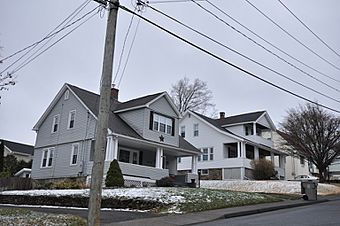South End Historic District (Bristol, Connecticut) facts for kids
Quick facts for kids |
|
|
South End Historic District
|
|
 |
|
| Location | Roughly bounded East Rd., Willis St., George St., and South St., Bristol, Connecticut |
|---|---|
| Area | 40 acres (16 ha) |
| Architect | Lockwood, B.R.; et.al. |
| Architectural style | Colonial Revival, Bungalow/craftsman, et.al. |
| NRHP reference No. | 00001625 |
| Added to NRHP | January 19, 2001 |
The South End Historic District is a special old neighborhood in Bristol, Connecticut. It's a place where you can see how people lived and worked long ago. This area grew as Bristol became an important factory town in the 1800s. It shows many different types of houses built from the mid-1800s to the mid-1900s. The district was added to the National Register of Historic Places in 2001, which means it's recognized as an important historical site.
Contents
The Story of Bristol's South End
Bristol started to grow a lot in the 1800s because of factories. A big part of this growth was clock-making. In 1821, a man named Chauncey Jerome came to Bristol and started a clock factory. His factory was built near the Pequabuck River. It quickly became very successful. By 1850, it was the biggest clock factory in the entire country!
Homes of Early Bristol
Chauncey Jerome built a beautiful house in 1832. It was located at the corner of Main and South Streets. This house is still a very important building in the historic district. Today, it is home to the local Elks lodge. Other factory owners and business people also built their homes on South Street.
As the town grew, more houses were built. These homes were for middle-class families. They were built on George and Hull Streets, just behind the bigger houses on South Street.
A Changing Neighborhood
By the late 1800s, many of the wealthiest families moved. They often moved to the north side of downtown. This area is now known as the Federal Hill area.
After this, the South End neighborhood continued to grow. More houses were built in the early 1900s. These homes were for middle and lower-class families. Only a few buildings in the district were built after World War II.
What You'll See Today
The South End Historic District covers about 40 acres. It includes more than 100 buildings that are important to history. Most of these buildings are made of wood.
The houses show many different styles. This is because they were built over more than 100 years. Homes on South and Hull Streets are usually from the 1800s. Houses on other streets were often built in the 1910s and 1920s. Some of the older, larger houses that were once for one family have been changed. Now, they have multiple apartments. You can also find many buildings that were built for two or three families.



